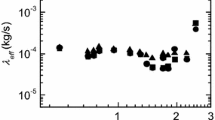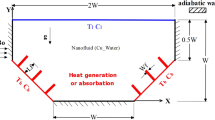Abstract
The paper presents the results of theoretical studies of the transport processes that take place in the newly proposed experiments on study of a vibrating quartz fork in superfluid \(^{3}\hbox {He}\)–\(^{4}\hbox {He}\) mixtures. In addition to known mechanisms of energy loss from a vibrating quartz fork such as first sound radiation or interaction with thermal excitations, two more mechanisms specific for \(^{3}\hbox {He}\)–\(^{4}\hbox {He}\) mixtures are proposed and studied in the paper. The relative contribution of these mechanisms: second sound and effective diffusion, is considered, and experimental conditions under which these mechanisms become effective are discussed.
Similar content being viewed by others
Avoid common mistakes on your manuscript.
1 Introduction
The using of a vibrating quartz fork in pure superfluid helium (HeII) became one of the useful methods for study of transport phenomena for the last 10 years [1,2,3,4,5,6,7,8,9]. A lot of interesting and unusual features were found in those experiments including, for example, the transition to the quantum turbulence regime [10, 11]. In some recent papers and reports, presented in the last QFS conference 2016 [12], the ideas of new experiments with a vibrating quartz fork immersed in superfluid \(^{3}\hbox {He}\)–\(^{4}\hbox {He}\) mixtures were presented.
These mixtures possess some properties that differ from the ones of pure helium. One of them is the presence of quasiparticles at any temperatures including the temperatures close to zero (quasiparticles of \(^{3}\hbox {He}\)). Another peculiarity is the very small value of typical interaction time between quasiparticles of \(^{3}\hbox {He}\); so, the gas of these quasiparticles can be always considered to be at equilibrium state. This assumption is valid at relatively high concentrations of 10–15% under which the new experiments are going to be carried out.
In this limit, the oscillation of a quartz fork will always cause the viscous motion of the nearest layers of the mixture and a certain part of energy will be transformed to the heat. So, the volume of liquid near the vibrating quartz fork in mixtures may be considered as a cylindrical oscillating source of heat and the solution of a problem of heat transfer with such a source can explain or predict phenomena of heat and mass transport in this system.
Heat transfer in superfluid \(^{3}\hbox {He}\)–\(^{4}\hbox {He}\) mixtures has a number of peculiarities. One of them is that in these mixtures heat is transferred both by the second sound mode and by the dissipative heat conductivity mode. The purpose of this work is to figure out under what conditions each of the modes dominates.
2 Heat Transfer Description
2.1 System of Hydrodynamics Equations
In this work, we consider the heat transfer in superfluid \(^{3}\hbox {He}\)–\(^{4}\hbox {He}\) mixtures with an oscillating cylindrical heat source. The radius of the heat source is \(r_{1}\), and as the boundary condition we will take the constant temperature at the outer cylindrical surface with the radius equal to \(r_{0}\).
To describe heat transfer in superfluid mixtures, we start from the Khalatnikov system of hydrodynamics equations [13]. Considering that helium is incompressible, after making some transforms and passing to cylindrical coordinates, we obtain the system of equations
where \(w(r, t)=v_{\mathrm{n}}-v_{\mathrm{s}}\) is the relative velocity of normal and superfluid velocities, \(\rho _{\mathrm{n}}\) and \(\rho _{\mathrm{s}}\) are the densities of normal and superfluid components, respectively; \(\rho _{0}\) is the equilibrium value of the total mixture density; c(r, t) is the concentration deviation from the equilibrium value \(c_{0}\); T(r, t) is the temperature deviation from the equilibrium value \(T_{0}, \chi =\kappa {/}C_{\mathrm{V}} \) is the temperature conductivity; \(\kappa \), D and \(Dk_{\mathrm{T}}\) are the thermal conductivity, diffusion and thermal diffusion coefficients, respectively. The value \(C_{\mathrm{V}}\) is the heat capacity, and \({\overline{S}} \) and \(\zeta \) are thermodynamic functions presented in [14, 15].
The boundary conditions have the form
Here Q and g are heat and concentration flows, respectively, which depend on gradients of temperature, concentration and velocities of normal and superfluid components [14, 15].
2.2 Results of Calculation
The solution of Eq. 1 with the boundary conditions (2) can be presented in the form
consisting of two terms, which refer to relaxation by diffusion and second sound. The respective Green functions \(G^{(\mathrm{Deff})}(r,t)\) and \(G^{(\mathrm{sound})}(r,t)\) are described in Refs. [14, 15] and explicitly presented in “Appendix” section to this paper. The relative contribution of diffusion and sound modes are determined by the factors \(u_{2N}^2 /u_2^2 \) and \(u_{2\varepsilon }^2 /u_2^2 \), where
is the second sound velocity,
The result (3) shows that the relation between the second sound mode and the dissipative mode depends on the ratio \(u_{2\varepsilon }^2 /u_{2N}^2 \) which are strongly depend on temperature and concentration. Some typical limiting cases are presented in Figs. 1, 2 and 3.
Figure 1 demonstrates the case, when the heat from an oscillating fork propagates in the mixture mainly by the dissipative mode, i.e. by effective thermal conductivity. This case refers to enough high concentration and low temperatures, when the number of thermal excitations of HeII is less than the number of \(\hbox {He}^{3}\) impurities.
The results for an opposite limiting case, when all the heat is transferred by second sound, are presented in Fig. 2. This case refers to almost pure helium. The figure shows oscillations that are typical for the second sound propagation.
In Fig. 3 the results for an intermediate case are presented and an exponential attenuation together with weak oscillations can be observed. The intermediate case, when contributions to heat transfer of the second sound mode and the dissipative mode are comparable, is presented in Ref. [14], where the respective concentrations and temperatures are found.
The obtained results show that in superfluid \(^{3}\hbox {He}\)–\(^{4}\hbox {He}\) mixtures two more ways for energy dissipation of a vibrating quartz fork can be observed. These mechanisms are second sound and effective diffusion, and they should be taken into account for planning new experiments.
3 Conclusion
The problem of heat transfer in cylindrical geometry (one-dimensional case) is considered. Relative contributions of the second sound mode and the dissipative mode to the temperature and the heat flow in superfluid helium mixtures with a periodic heater were explored. The obtained results can be used for planning and description of experiments where temporal and spatial evolution of temperature, concentration or heat flow is studied, e.g. studying temporal evolution of heat flow in helium in experiments with an oscillating tuning fork immersed to superfluid \(^{3}\hbox {He}\)–\(^{4}\hbox {He}\) mixtures. The results of the first such experiments made in Kharkov Institute of Low Temperatures have appeared, and they showed that some energy losses of vibrating fork immersed to superfluid \(^{3}\hbox {He}\)–\(^{4}\hbox {He}\) mixtures unexplained by known mechanisms are observed [16].
References
D.O. Clubb, O.V.L. Buu, R.M. Bowley, R. Nyman, J.R. Owers-Bradley, J. Low Temp. Phys. 136, 1 (2004)
M. Blažková, D. Schmoranzer, L. Skrbek, Phys. Rev. E 75, 025302-1 (2007)
M. Blažková, M. Človečko, E. Gažo, L. Skrbek, P. Skyba, J. Low Temp. Phys. 148, 305 (2007)
M. Blažková, M. Človečko, V.B. Eltsov, E. Gažo, R. de Graaf, J.J. Hosio, M. Krusius, D. Schmoranzer, W. Schoepe, L. Skrbek, P. Skyba, R.E. Solntsev, W.F. Vinen, J. Low Temp. Phys. 150, 525 (2008)
E.M. Pentti, J.T. Tuoriniemi, A.J. Salmela, A.P. Sebedash, J. Low Temp. Phys. 150, 555 (2008)
E. Pentti, J. Rusti, A. Salmela, A. Sebedash, J. Tuoriniemi, REPORT TKK-KYL-020, 36 (2009)
D. Schmoranzer, M. La Mantia, G. Sheshin, I. Gritsenko, A. Zadorozhko, M. Rotter, L. Skrbek, J. Low Temp. Phys. 136, 317 (2011)
A. Salmela, J. Tuoriniemi, J. Rysti, J. Low Temp. Phys. 162, 678 (2011)
D.I. Bradley, M. Človečko, S.N. Fisher, D. Garg, E. Guise, R.P. Haley, O. Kolosov, G.R. Pickett, V. Tsepelin, D. Schmoranzer, S. Skrbek, Phys. Rev. B 85, 014501 (2012)
R. Blaauwgeers, M. Blazkova, M. Človečko, V.B. Eltsov, R. De Graaf, J. Hosio, M. Krusius, D. Schmoranzer, W. Schoepe, L. Skrbek, P. Skyba, R.E. Solntsev, D.E. Zmeev, J. Low Temp. Phys. 146, 537 (2007)
G.A. Sheshin, A.A. Zadorozhko, E.Y. Rudavskii, V.K. Chagovets, L. Skrbek, M. Blazkova, J. Low Temp. Phys. 34, 1111 (2008)
V. Bakhvalova, V. Chagovets, I. Gritsenko, A.G. Sheshin, J. Low Temp. Phys. (2016). doi:10.1007/s10909-016-1712-8
I.M. Khalatnikov, An Introduction to the Theory of Superfluidity (Addison-Wesley, Redwood City, 1989)
K. Nemchenko, S. Rogova, J. Mol. Liq. 151, 187 (2010)
K. Nemchenko, S. Rogova, J. Low Temp. Phys. 175, 85 (2014). doi:10.1007/s10909-016-1712-8
V. Chagovets, G. Sheshin (Private communication, 2016)
Acknowledgements
Authors cordially thank the researchers from the Institute of Low Temperature Physics, Kharkov Dr. V. Chagovets and Dr. G. Sheshin for private communication about the preliminary results of experiments with a vibrating fork immersed to superfluid \(^{3}\hbox {He}\)–\(^{4}\hbox {He}\) mixtures.
Author information
Authors and Affiliations
Corresponding author
Appendix
Appendix
After Laplace transform of the system (1) and excluding w(r, t), the system of two equations is obtained
where \(\Delta _{\mathrm{r}}\) is Laplacian in cylindrical coordinates, p is a parameter of Laplace transform (inverse time). Here
The system (6) can be transformed to the diagonal form
where \(F=T+\alpha _{1}c\, G=T+\alpha _2c\) are linear combinations, and
The solution of system (5) can be written as
where \(I_{0}\) and \(K_{0}\) are modified Bessel functions.
Substitution of (6)–(8) gives the final result for concentration and temperature
Here \(F_{i}, G_{i}\,(i=1,2)\) are constants depending on p that are found from the boundary conditions and finally give the results (3) of the paper.
Rights and permissions
About this article
Cite this article
Nemchenko, K., Rogova, S. & Vikhtinskaya, T. Heat Transfer in \(^{3}\hbox {He}\)–\(^{4}\hbox {He}\) Mixtures in Cylindrical Geometry. J Low Temp Phys 187, 324–330 (2017). https://doi.org/10.1007/s10909-017-1761-7
Received:
Accepted:
Published:
Issue Date:
DOI: https://doi.org/10.1007/s10909-017-1761-7







